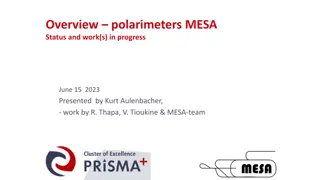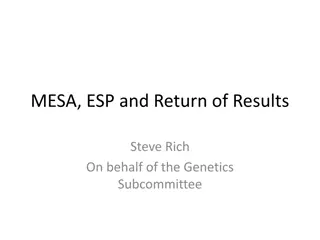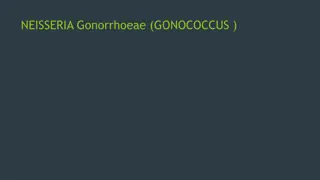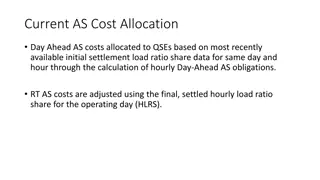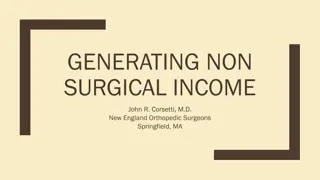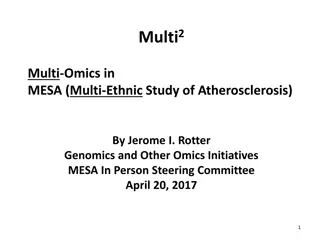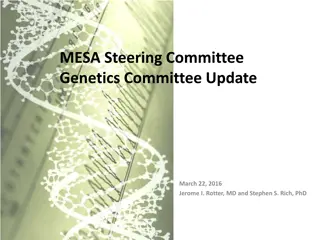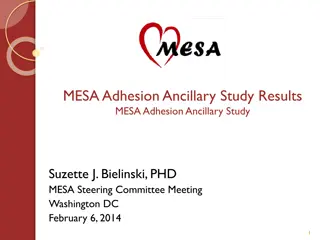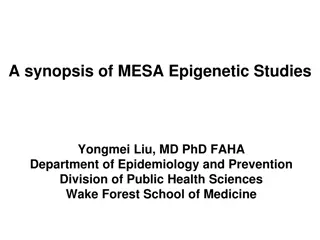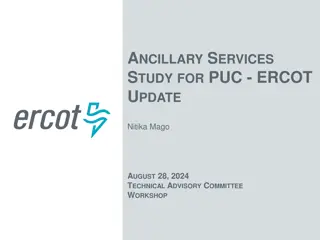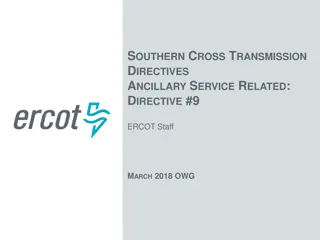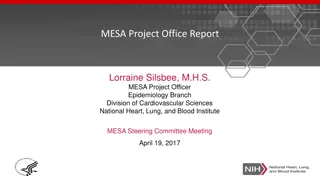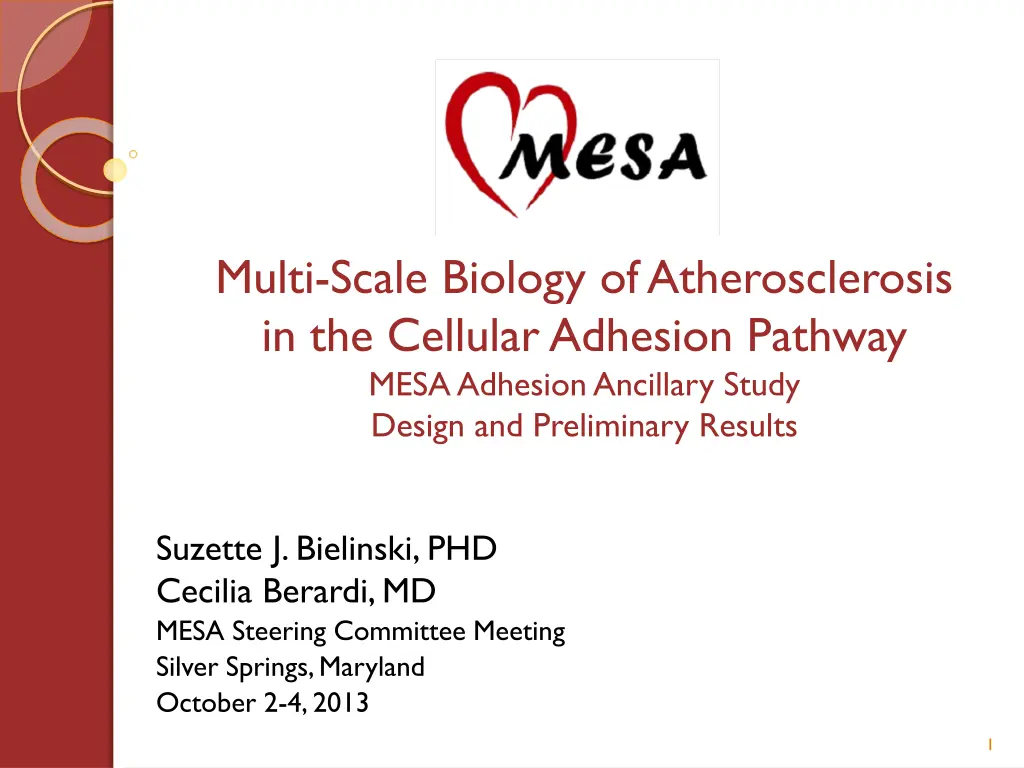
Atherosclerosis Cellular Adhesion Pathway Study
Explore the Multi-Scale Biology of Atherosclerosis in the Cellular Adhesion Pathway through the MESA Adhesion Ancillary Study. Meet the research team, delve into the background, aims, progress, preliminary data, and future plans of this study. Understand the significance of cellular adhesion in atherosclerosis and how proteins in the cellular adhesion pathway play a crucial role.
Uploaded on | 2 Views
Download Presentation

Please find below an Image/Link to download the presentation.
The content on the website is provided AS IS for your information and personal use only. It may not be sold, licensed, or shared on other websites without obtaining consent from the author. If you encounter any issues during the download, it is possible that the publisher has removed the file from their server.
You are allowed to download the files provided on this website for personal or commercial use, subject to the condition that they are used lawfully. All files are the property of their respective owners.
The content on the website is provided AS IS for your information and personal use only. It may not be sold, licensed, or shared on other websites without obtaining consent from the author.
E N D
Presentation Transcript
Multi-Scale Biology of Atherosclerosis in the Cellular Adhesion Pathway MESA Adhesion Ancillary Study Design and Preliminary Results Suzette J. Bielinski, PHD Cecilia Berardi, MD MESA Steering Committee Meeting Silver Springs, Maryland October 2-4, 2013 1
Outline 1. Introduce the MESA Adhesion Team 2. Background 3. Specific Aims 4. Progress to Date 5. Preliminary Data 6. Future Plans 2
MESA Adhesion Research Team Site Name Role Suzette J. Bielinski, PhD Mariza de Andrade, PhD Paul A. Decker, MS Phil Kirsch, MPH Hughes Sicotte, PhD Cecilia Berardi, MD Michael Tsai, MD Principal Investigator Statistician Statistician Statistical Programmer Bioinformatician Post-doctoral Fellow MESA Core Lab Mayo Clinic, Rochester Naomi Hanson, MS James S. Pankow, PhD Weihong Tang, PhD Michele Sale, PhD Christina Wassel, PhD MESA Core Lab Co-Investigator Co-Investigator MESA Genotype Lab Co-Investigator University of Minnesota University of Virginia University of Pittsburgh 3
Background Cellular Adhesion and Atherosclerosis Reprinted from Cell, Vol 104, CK Glass et al, Atherosclerosis: The Road Ahead, pp 503-516, 2001, with permission from Elsevier.
Background- Immunoglobulin Superfamily Intercellular Adhesion Protein 1 (ICAM1) Atherosclerosis Risk In Communities (ARIC) Study Population cohort of n = 15,792, (Hwang et al., 1997) *OR = 5.5 for incident CHD *OR = 2.6 for carotid IMT Physicians Health Study, (Ridker et al., 1998) *RR = 1.8 for incident MI Women s Health Study, (Ridker et al., 2000) *RR = 2.6 for cardiovascular events *Highest quartile compared to lowest
Background Cellular Adhesion 1. Immunoglobulin superfamily 2. Selectins 3. Integrins 4. Cadherins Linking the processes of homostasis, thrombosis, and inflammation include chemokines, kinases, cytokines, growth factors, matrix metalloproteinases, etc 6
Cellular Adhesion Pathway Ingenuity Neighborhood Explorer and MetaCore Pathway Protein Selection 1. Extracellular or cleaved proteins 2. Biologic Plausibility 3. Circulates in serum or plasma 4. Availability of high quality commercial assay Proposed to measure 15 adhesion pathway proteins 7
Specific Aims Aim 1: To test the hypothesis that the adhesion pathway is associated with subclinical atherosclerosis Aim 2: To test the hypothesis that variants in adhesion genes account for a significant portion of the variation in adhesion protein level and that these variants are associated with subclinical atherosclerosis Aim 3: To replicate the strongest associations from Aims 1 & 2 8
MESA Adhesion Proteins Mean and Standard Deviation of Circulating Adhesion Protein Level by Ethnicity in MESA measured at Exam 2 European Chinese African Hispanic p value n 619 600 579 603 VCAM-1, ng/mL 784 (225) 742 (227) 668 (223) 757 (238) < 0.001 P-selectin, ng/mL 58.1 (20.3) 42.6 (14.7) 45.7 (17.6) 60.6 (19.8) < 0.001 L-selectin, ng/mL 956 (215) 834 (175) 867 (192) 904 (196) < 0.001 E-Cadherin, ng/mL 215 (58.4) 227 (63.8) 209 (59.4) 247 (75.1) < 0.001 MMP-1, ng/mL 5.5 (4.0) 5.5 (3.6) 6.0 (4.9) 5.4 (4.3) 0.2769 MMP-2, ng/mL 196 (30.3) 190 (28.9) 201 (35.2) 198 (31.0) < 0.001 TIMP-2, ng/mL 83.0 (13.1) 76.9 (11.0) 82.8 (13.6) 81.9 (11.7) < 0.001 6Ckine, pg/mL 844 (280) 779 (281) 811 (289) 813 (280) < 0.001 RANTES, pg/mL 4195 (3969) 4385 (3317) 4334 (4611) 4284 (4287) < 0.001 SDF1a, pg/mL 1904 (434) 1998 (436) 1947 (481) 1942 (447) 0.002 HGF, pg/mL 1005 (254) 876 (200) 982 (265) 1099 (260) < 0.001 TGFb1, pg/mL 3708 (2162) 4385 (2225) 3908 (2513) 3855 (2250) < 0.001 SLPI, pg/mL 45525 (10058) 44977 (10250) 47677 (12241) 47439 (10626) < 0.001 10
MESA Adhesion Proteins Not measured Monocyte Chemotactic Protein 3 (MCP3) Epidermal Growth Factor (EGF) Added on the 2880 at exam 2 ICAM-1 IL2sr Replication Proteins HGF P-selectin 11
Subclinical Measures and Events Race/Ethnicity % of MESA European - 100 50 295 50 25 75 100 50 283 50 25 75 100 - 100 - 100 Measure Exam Chinese African Hispanic MESA 2880 Sample 1 1 2 3 4 5 1 2 3 4 5 1 2 3 4 5 720 620 720 600 720 579 720 604 282 276 293 Coronary Artery Calcium Score (CAC) 270 278 249 255 220 360 608 113 317 598 165 326 560 165 333 587 288 268 274 260 277 233 Carotid Ultrasound (IMT) 257 184 375 616 111 367 596 145 334 575 143 324 597 548 550 512 523 ABI 445 50 433 21 403 36 415 47 Post -exam 2 CVD events FU10 Counts includes all those with serum proteins measured
Preliminary Data VCAM1 Expressed on endothelial cells Cleaved by ADAM17 Limited evidence on VCAM-1 role as a marker of clinical and subclinical atherosclerosis 13
Preliminary Data VCAM1 Association of VCAM-1 levels and CV risk factors Non-Hispanic whites Chinese Americans African Americans Hispanic Americans Characteristic p-value p-value p-value p-value 0.03 <0.001 0.04 <0.001 0.03 <0.001 0.03 <0.001 Age, years Total Cholesterol, mg/dl -0.006 <0.001 -0.007 <0.001 -0.0004 0.72 -0.005 <0.001 LDL Cholesterol, mg/dl -0.005 <0.001 -0.007 <0.001 -0.0003 0.80 -0.005 <0.001 Hypertension -0.34 <0.001 -0.48 <0.001 -0.31 <0.001 -0.22 0.009 Alcohol, current use 0.31 <0.001 0.15 0.095 0.26 <0.001 0.22 0.008 per SD of VCAM-1 level for the population=231.8 14
Preliminary Data VCAM1 Non-Hispanic whites Chinese Americans African Americans Hispanic Americans Outcomes CAC Exam 2 p p p p (S.E.) 21.9 (56.4) 43.3 (57.6) (S.E.) 55.0 (35.3) 27.5 (34.3) (S.E.) 29.9 (50.4) 28.2 (53.0) (S.E.) -34.7 (50.1) -56.1 (49.8) Model 1 0.7 0.1 0.6 0.5 Model 2 0.5 0.4 0.6 0.3 CACExam 3 Model 1 -43.5 (50.2) -46.5 (54.3) HR (CI) 0.84 (0.5, 1.3) 0.87 (0.5, 1.4) 0.4 -16.6 (41.8) -10.8 (41.9) HR (CI) 0.97 (0.6, 1.7) 1.08 (0.6, 1.9) 0.7 157.3 (63.2) 195.3 (63.4) HR (CI) 1.52 (1.1, 2.1) 1.70 (1.2, 2.4) 0.013 21.2 (35.0) 7.15 (35.8) HR (CI) 1.13 (0.8, 1.6) 1.12 (0.8, 1.6) 0.5 Model 2 0.4 0.8 0.002 0.8 Time to CHD p p p p Model 1 0.4 0.9 0.008 0.5 Model 2 0.6 0.8 0.003 0.5 Model 1 = age and sex Model 2 = age, sex, BMI, smoking status, LDL, HDL, triglycerides, hypertension, diabetes per SD of VCAM-1 level for the population=231.8 15
Genetic Data MESA Genotype Sources Candidate Gene IBC Chip Exome Chip Collaboration of MESA Adhesion, Air, and Genotype groups CardiometaboChip GWAS available through SHARE or dbGAP 16
Predicting ABO Phenotypes Prediction of the ABO haplotypes is based on the data in Yip (2002) Sequence variation of the human ABO locus. Ann Hum Genet 66: 1-27 The blood group determination is then based on the dominance rules A and B co-dominant, dominant over O Many of those SNPs are ambiguous (A/T or C/G), which makes correct phase assignment both crucial and tricky. We have genotype or imputed data for all those SNPs or indel. 18
Future Plans 1. Collaboration with Dr. Kanaya - expansion of this work to include the MASALA Population 2. Renewal of MESA Adhesion 3. Collaborations with PAGE and other consortia 19
Questions Contact email Bielinski.suzette@mayo.edu 20

